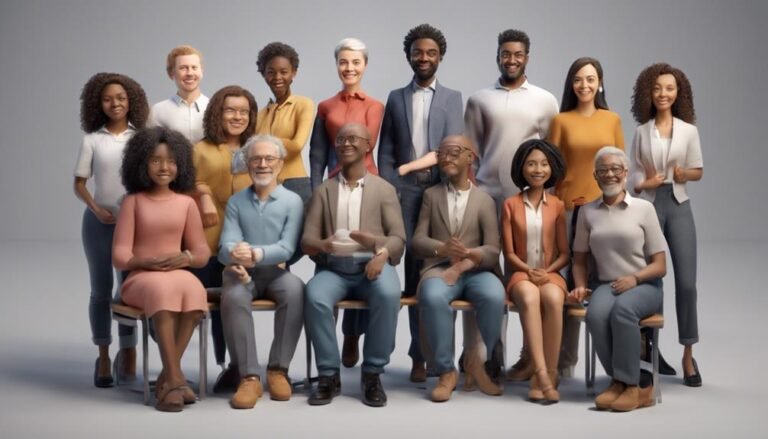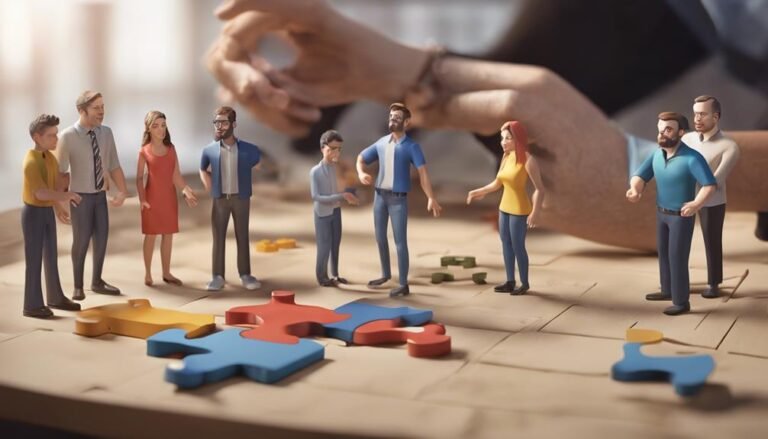Communication as a Soft Skill
Mastering communication as a soft skill is essential for career success. Understanding verbal and nonverbal cues improves interactions. Active listening and conflict resolution strategies enhance relationships. Embrace cultural differences to communicate effectively. In the digital age, virtual communication manners are paramount. Demonstrating empathy and clarity fosters teamwork. Improving your communication skills boosts productivity and morale. Discover how honing your communication abilities can propel you forward professionally.
Key Takeaways
- Communication skills are vital for effective interactions and team productivity.
- Understanding cultural differences enhances communication effectiveness.
- Adapt feedback styles to promote open communication and prevent misunderstandings.
- Embracing diversity enriches interactions and fosters inclusivity.
- Effective communication is fundamental for building strong relationships and trust.
Importance of Communication Skills
Understanding the significance of communication skills is essential in fostering effective interactions and relationships in both personal and professional settings. One vital aspect of communication is providing effective feedback. By mastering the art of giving feedback constructively and positively, you can enhance productivity and growth within your team or personal relationships. Acknowledging cultural differences is also paramount in communication. Being aware of how cultural nuances can impact communication styles and preferences will help you navigate conversations with respect and understanding.
When offering feedback, consider the cultural background of the individual receiving it. Different cultures may have varying expectations regarding feedback, such as directness versus indirectness. By adapting your feedback style to accommodate cultural differences, you promote open communication and prevent misunderstandings. Embracing cultural diversity in communication enriches interactions and fosters a more inclusive environment. Remember, effective feedback and cultural sensitivity are key components of successful communication in any setting.
Types of Communication Styles
Understanding the differences between verbal and nonverbal cues is crucial when it comes to communication styles.
Moreover, acknowledging the distinctions between direct and indirect forms of communication can significantly influence your interactions with others.
Verbal Vs. Nonverbal
While verbal communication involves the use of spoken words, nonverbal communication encompasses gestures, facial expressions, and body language to convey messages. Nonverbal cues often play a significant role in how messages are perceived and understood in various interactions.
- Body Language: The way you stand, sit, or move can convey a lot about your feelings and intentions without saying a word.
- Gestures and Expressions: Hand movements, facial expressions, and eye contact can all add layers of meaning to your verbal communication.
- Tone of Voice: The tone in which you speak can sometimes convey more than the actual words you're saying, impacting the message's overall reception.
Direct Vs. Indirect
Moving on from the distinction between verbal and nonverbal communication, let's now look at the different communication styles, specifically the Direct Vs. Indirect types. When considering Direct communication, individuals express their thoughts and feelings clearly and openly. On the other hand, Indirect communication involves a more subtle approach, where messages may be implied rather than directly stated. Cultural differences play a significant role in shaping these communication styles. Direct communication is often preferred in Western cultures for its clarity in message delivery, whereas Indirect communication is more common in Eastern cultures where harmony and implicit messages are valued. Understanding and adapting to these differences can greatly enhance effective communication across diverse cultural backgrounds.
| Direct Communication | Indirect Communication |
|---|---|
| Clear and explicit | Implied and subtle |
| Straightforward | Indirect implications |
| Western preference | Eastern preference |
Nonverbal Communication Cues
To convey your message effectively, pay attention to subtle nonverbal communication cues. Body language and facial expressions play an essential role in how your message is perceived by others. Understanding nonverbal cues can help you improve your communication skills and build stronger relationships.
Here are three key nonverbal communication cues to ponder:
- Eye Contact: Maintaining appropriate eye contact shows that you're engaged and interested in the conversation. It conveys confidence and attentiveness.
- Gestures: Using gestures can enhance your message and make it more engaging. However, be mindful of the cultural differences in gestures to avoid misunderstandings.
- Posture: Your posture can convey a lot about your attitude and emotions. Standing or sitting up straight can signal confidence and openness, while slouching may indicate disinterest or lack of confidence.
Active Listening Techniques
Engage with the speaker by demonstrating active listening techniques to show your genuine interest and understanding in the conversation. To practice empathy, focus on the speaker without distractions. Maintain eye contact, nod occasionally, and provide verbal cues like 'I see' or 'Go on' to show you're actively listening. Reflect on what the speaker is saying by restating their words to confirm you understand correctly. This not only clarifies any misunderstandings but also demonstrates your engagement in the conversation.
Another effective technique is to ask open-ended questions that encourage the speaker to elaborate on their thoughts and feelings. This shows that you value their perspective and are genuinely interested in what they've to say. Avoid interrupting or imposing your opinions; instead, give the speaker the space to express themselves fully. By practicing these active listening techniques, you create a supportive and respectful environment that fosters open communication and deeper connections with others.
Conflict Resolution Strategies
When addressing conflicts, it's essential to approach the situation with a focus on understanding different perspectives and finding mutually beneficial solutions. In conflict resolution, employing mediation techniques can be highly effective. Mediation involves a neutral third party facilitating discussions between conflicting parties to reach a resolution. This method helps in fostering open communication and understanding between individuals.
Negotiation tactics play an important role in resolving conflicts amicably. By using effective negotiation strategies, individuals can find common ground and work towards mutually agreeable outcomes. Active listening, empathy, and clear communication are key components of successful negotiation.
Communication strategies are crucial in conflict resolution. Clearly expressing your thoughts and actively listening to the other party can help in de-escalating conflicts. By maintaining a respectful and open dialogue, conflicts can be resolved more efficiently, leading to improved relationships and outcomes.
Building Relationships Through Communication
Getting through conflicts with effective communication can lay the foundation for building strong and lasting relationships. Essential building is a vital component of nurturing relationships. By openly communicating your thoughts and feelings, you can establish trust with others. When you're transparent in your communication, it shows that you value honesty and integrity, which are key for any healthy relationship.
Connection building is also about active listening. When you listen attentively to others, you show respect and genuine interest in what they have to say. This fosters a sense of connection and understanding, strengthening the bond between you and the other person.
Moreover, showing empathy in your communication can go a long way in building relationships. Understanding and acknowledging the emotions of others can create a supportive environment where people feel valued and respected.
Communication in the Digital Age
Traversing communication in the digital age requires a keen understanding of the nuances and challenges posed by virtual interactions. In today's fast-paced world, mastering digital etiquette and effectively engaging in virtual communication are essential skills.
Here are three key aspects to ponder:
- Mindful Online Presence: Being mindful of your online presence is pivotal. Remember that your digital footprint can have a lasting impact on your professional reputation. Practice caution and thoughtfulness in your online interactions to maintain a positive image.
- Clear and Concise Communication: In virtual communication, clarity is essential. Due to the absence of non-verbal cues, misunderstandings can easily arise. Make sure your messages are concise, well-structured, and free of ambiguity to convey your thoughts accurately.
- Timely Responses: Prompt responses are crucial in the digital domain. Whether it's replying to an email, message, or comment, endeavor to maintain timely communication to demonstrate respect and reliability in your virtual interactions.
Communicating Effectively in Teams
When working in teams, understanding team dynamics and fostering synergy are essential for success.
You must practice active listening skills to guarantee effective communication and collaboration.
Clear roles and responsibilities help streamline tasks and prevent confusion within the team.
Team Dynamics and Synergy
To promote effective team dynamics and synergy, open and honest communication is vital among all team members. Successful team collaboration depends on understanding group dynamics and working together towards common goals.
Here are three key points to ponder:
- Promote Inclusivity: Guarantee that all team members have the opportunity to contribute ideas and perspectives, nurturing a sense of belonging and value within the team.
- Address Conflicts Promptly: Handle any conflicts or disagreements openly and constructively to prevent them from escalating and disrupting team cohesion.
- Commend Achievements Together: Recognize and celebrate both individual and team accomplishments to boost morale and strengthen the sense of unity within the group.
Active Listening Skills
To enhance team communication and foster collaboration, mastering active listening skills is imperative for effective teamwork. Active listening involves more than just hearing words; it requires engaging with your teammates through empathetic responses and reflective listening.
By showing genuine interest in what others have to say, you can build trust and create a supportive team environment. Utilizing open-ended questions encourages deeper discussions and allows for a better understanding of different perspectives within the team.
Additionally, paying attention to body language cues can help you interpret unspoken feelings and thoughts, leading to improved communication and stronger connections. Practice these active listening techniques consistently to enhance team dynamics and achieve greater synergy in your collaborative efforts.
Clear Roles and Responsibilities
Mastering clear roles and responsibilities within a team is essential for effective communication and successful collaboration. When each team member understands their role clearly, it fosters a more efficient and harmonious working environment. Here are three key points to contemplate:
- Enhanced Team Collaboration: Clearly defined roles help team members understand their contributions to the overall goal, leading to better coordination and collaboration.
- Improved Efficiency: Role clarity reduces confusion and duplication of efforts, streamlining processes and increasing productivity.
- Effective Decision-Making: When responsibilities are well-defined, decision-making becomes more structured and efficient, enabling the team to make timely and informed choices.
Ensuring role clarity is fundamental to achieving seamless teamwork and achieving shared objectives.
Enhancing Communication Skills for Success
Improve your communication skills to boost your chances of achieving success in various aspects of your life. Important feedback plays a vital role in honing your communication abilities. By actively seeking feedback from others, you can identify areas for improvement and refine your communication style. Constructive criticism helps you understand how your message is received and allows you to adjust accordingly.
Additionally, practicing assertive communication is key to getting your point across clearly and confidently. Being assertive involves expressing your thoughts and feelings while respecting the opinions of others. This approach fosters open and honest communication, leading to more productive interactions and better outcomes. Remember to use 'I' statements to convey your thoughts assertively without sounding aggressive.
Enhancing your communication skills through effective feedback and assertive communication won't only benefit your personal relationships but also boost your professional success. Clear and confident communication is a valuable asset that can help you navigate various challenges and excel in your endeavors.
Conclusion
Now that you've learned about the importance of communication as a soft skill, remember that effective communication is the key to success in any aspect of your life.
By mastering different communication styles, practicing active listening, and resolving conflicts with ease, you can build stronger relationships and thrive in both personal and professional settings.
So, go ahead and start enhancing your communication skills today to reveal a world of opportunities and achieve your goals with confidence.








